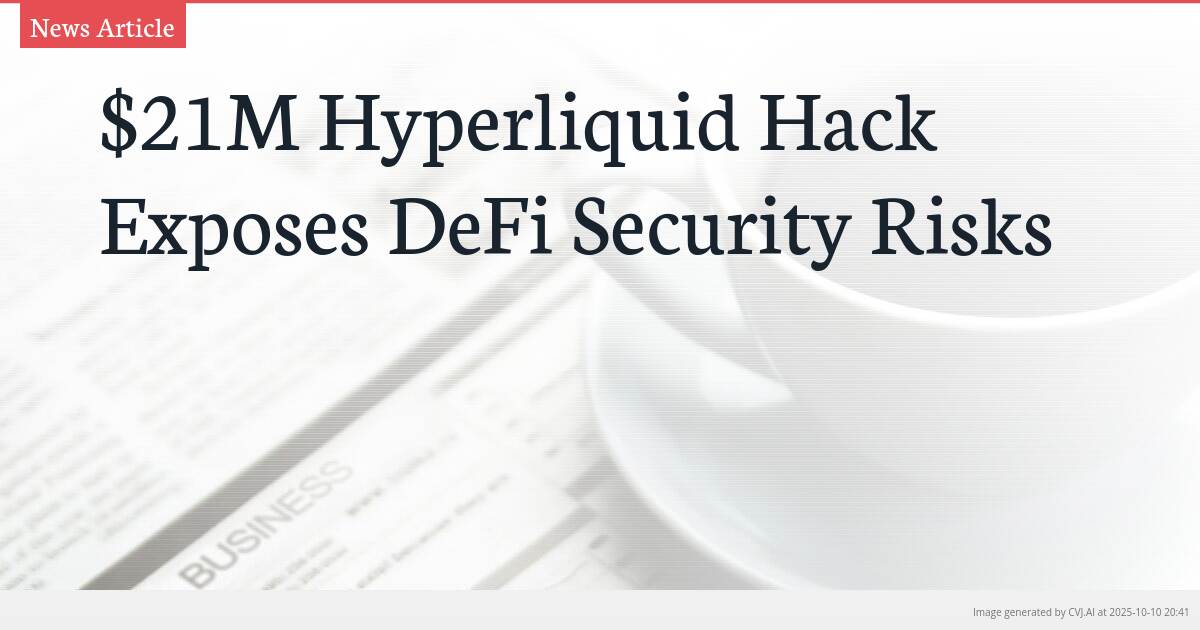This summary text is fully AI-generated and may therefore contain errors or be incomplete.
Introduction
A Hyperliquid trader suffered a devastating $21 million loss due to a private key exploit, highlighting persistent security vulnerabilities in decentralized finance. The incident involved the platform’s Hyperdrive lending protocol and represents one of the largest individual losses in recent DeFi history. Blockchain analysts are investigating how the private key was compromised in this sophisticated attack.
Key Points
- Attack targeted Hyperliquid's Hyperdrive lending protocol, resulting in $21 million loss from a single user
- Hacker stole 17.75 million DAI and 3.11 million SyrupUSDC before bridging funds to Ethereum
- Blockchain security firm PeckShield investigating the private key compromise method
The Anatomy of a $21 Million Exploit
The security breach unfolded on Thursday when an attacker gained unauthorized access to a single user’s account on the Hyperliquid decentralized trading platform. According to blockchain security firm PeckShield, the exploit specifically targeted the platform’s Hyperdrive lending protocol, resulting in the theft of approximately $21 million in digital assets. The attacker methodically drained 17.75 million DAI, a popular decentralized stablecoin, along with 3.11 million SyrupUSDC, which represents a synthetic version of the USDC stablecoin specifically designed for use within Hyperliquid’s ecosystem.
Following the successful extraction of funds from the Hyperdrive protocol, the perpetrator executed a sophisticated cross-chain transfer, bridging the stolen assets to the Ethereum network. This strategic move demonstrates the attacker’s familiarity with multi-chain operations and their intent to obscure the trail of stolen funds across different blockchain environments. The scale of this exploit places it among the most significant individual losses in the recent history of decentralized finance, raising urgent questions about security protocols and user protection measures within the rapidly expanding DeFi sector.
The Private Key Vulnerability Crisis
At the heart of this security incident lies the critical issue of private key management, which remains one of the most persistent vulnerabilities in the cryptocurrency ecosystem. While PeckShield has confirmed the attack vector as a private key exploit, the specific method of compromise remains undetermined. This uncertainty underscores the multifaceted nature of security threats facing DeFi participants, ranging from phishing attacks and malware infections to more sophisticated social engineering tactics targeting high-net-worth individuals.
The Hyperliquid incident exemplifies the catastrophic consequences that can result from a single point of failure in user security practices. Unlike traditional financial systems where institutions bear responsibility for security breaches, decentralized exchanges like Hyperliquid operate on a self-custody model where users maintain full control—and full responsibility—for their private keys. This $21 million loss serves as a stark reminder that even experienced traders operating on sophisticated DEX platforms remain vulnerable to fundamental security lapses, particularly when dealing with substantial asset portfolios.
Implications for DeFi Security and User Vigilance
This high-profile exploit arrives amid growing decentralized exchange activity across the cryptocurrency market, highlighting the tension between DeFi’s promise of financial sovereignty and the practical security challenges it presents. The Hyperliquid breach demonstrates that even protocols with advanced features like Hyperdrive lending are only as secure as the users’ ability to protect their private keys. The incident raises critical questions about whether current security education and tooling are adequate to protect users managing significant assets in decentralized environments.
The response from the security community, particularly firms like PeckShield, will be crucial in determining how future incidents might be prevented. While blockchain analytics can trace the movement of stolen funds after an exploit occurs, the fundamental challenge remains preventing the initial compromise. This case underscores the need for enhanced security infrastructure, including more robust key management solutions, multi-signature requirements for large transactions, and improved user education about security best practices.
As DeFi continues to mature and attract larger institutional participants, incidents like the Hyperliquid exploit serve as critical learning opportunities for the entire ecosystem. The bridging of stolen DAI and SyrupUSDC to Ethereum demonstrates the interconnected nature of modern DeFi and the need for comprehensive security approaches that span multiple chains and protocols. Ultimately, this $21 million loss may catalyze important conversations about balancing user autonomy with protective measures that can prevent catastrophic financial losses in the decentralized finance landscape.
📎 Read the original article on cointelegraph.com

